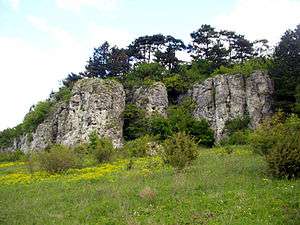Medobory Nature Reserve
Medobory Nature Reserve (Ukrainian: Природний заповідник «Медобори») is a protected nature reserve of Ukraine located in the Podolian Upland in the western part of the country. It protects a representative portion of the "Tovtry" region, known for rocky limestone ridges. The reserve is in the administrative districts of Husiatyn and Pidvolochysk in Ternopil Oblast.[1][2]
| Medobory Nature Reserve | |
|---|---|
| Ukrainian: Медобори (заповідник) | |
IUCN category Ia (strict nature reserve) | |
 Medobory Nature Reserve | |
 Location of Reserve | |
| Location | Ternopil Oblast, Husiatyn Raion |
| Nearest city | Hrymailiv |
| Coordinates | 49°12′0″N 26°10′0″E |
| Area | 10,521 hectares (25,998 acres; 105 km2; 41 sq mi) |
| Established | 1990 |
| Governing body | State Forest Resources Agency Ukraine |
| Website | http://www.medobory-reserve.te.ua/ |
Topography
The reserve occupies a section of the Tovtry region, a 200 km long limestone ridge that formed as a reef in a warm Miocene sea some 15-20 million years ago. The ridge is highly desiccated and eroded, rising 60-100 meters above the surrounding territory. The southwestern slopes of the ridge is steep, the northeastern slope gradually flattens. The highest point in the reserve is Mount Bogit (414 meters). The Zbruch River runs along the eastern edge of the reserve.
Climate and ecoregion
The climate of the Medobory area is Humid continental climate, warm summer (Köppen climate classification (Dfb)). This climate is characterized by large seasonal temperature differentials and a warm summer (at least four months averaging over 10 °C (50 °F), but no month averaging over 22 °C (72 °F).[3][4]. In the reserve, the average temperature in January is −3 °C (27 °F) and 18 °C (64 °F) in July. Precipitation averages 620 mm/year.[1]
Medobory is located in the Central European mixed forests ecoregion, a temperate hardwood forest covering much of northeastern Europe, from Germany to Russia.[5]
Flora and fauna
93% of the reserve is forested, mostly in oak-hornbeam, oak-hornbeam-ash, and oak-beech stands. The soils are loam and limestone, supporting a wide variety of plants. Over 1,000 species of vascular plants have been recorded in the area.[2]
Public use
As a strict nature reserve, Medobory's primary purpose is protection of nature and scientific study. Public access is limited: mass recreation and construction of facilities is prohibited as are hunting and fishing.[2] The public may access a limited number of ecological trail under supervision of reserve staff.
See also
- Lists of Nature Preserves of Ukraine (class Ia protected areas)
- National Parks of Ukraine (class II protected areas)
References
- "Medobory Nature Reserve" (in Ukrainian). Ukraine Incognita. Retrieved June 18, 2019.
- "Medobory Nature Reserve" (in Ukrainian). Official Reserve Website. Retrieved August 10, 2019.
- Kottek, M., J. Grieser, C. Beck, B. Rudolf, and F. Rubel, 2006. "World Map of Koppen-Geiger Climate Classification Updated" (PDF). Gebrüder Borntraeger 2006. Retrieved September 14, 2019.CS1 maint: multiple names: authors list (link)
- "Dataset - Koppen climate classifications". World Bank. Retrieved September 14, 2019.
- "Map of Ecoregions 2017". Resolve, using WWF data. Retrieved September 14, 2019.
External links
| Wikimedia Commons has media related to Medobory Nature Reserve. |
